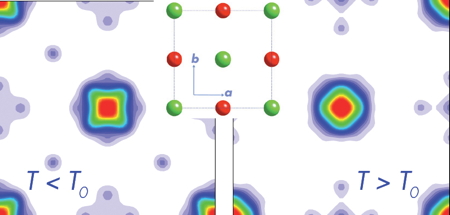The intermetallic heavy fermion URu2Si2 is a member of the family of superconducting uranium compounds. In addition to the superconducting transition observed at 1.2 K, a second transition is clearly visible at T0 = 17.5K. Whereas this transition is easily detected in many macroscopic measurements such as specific heat, electrical resistivity, thermal expansion or magnetic susceptibility, it gives no clear microscopic signal to elastic scattering neither by neutrons nor by x-rays. To explain this second transition, theoretical models have been successively proposed over the years, including high rank multipoles ordering. Let us recall that a classical magnetic transition corresponds to an order of dipolar moments (multipoles of rank 1).
In collaboration with the Néel institute, we have measured by polarized neutron diffraction at the ILL the magnetization distribution induced in a single crystal of URu2Si2 by a strong magnetic field applied along the tetragonal c axis. A change in the shape of the magnetization distribution around the uranium atoms has been evidenced: whereas this distribution looks elongated along the [110] and [1-10] direction at T = 2K, a change of symmetry is visible when crossing T0, resulting in a distribution elongated along [100] and [010] at T = 25K. To account for this rotation, a possible scenario is the action on the fundamental ground state of the uranium ion of a rank 5 operator. This operator, a dotriocontapole, is the product of 5 angular momentum operators.

Projection along the tetragonal c axis of the magnetization distribution induced by magnetic field Bext = 9.6T applied along this axis, below and above T0. Positions of uranium and ruthenium atoms are indicated.